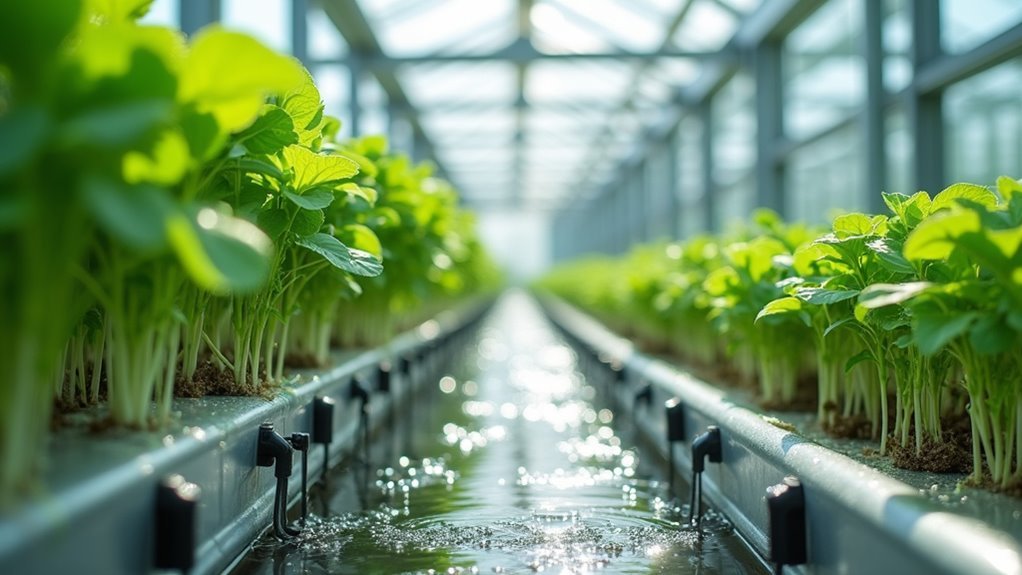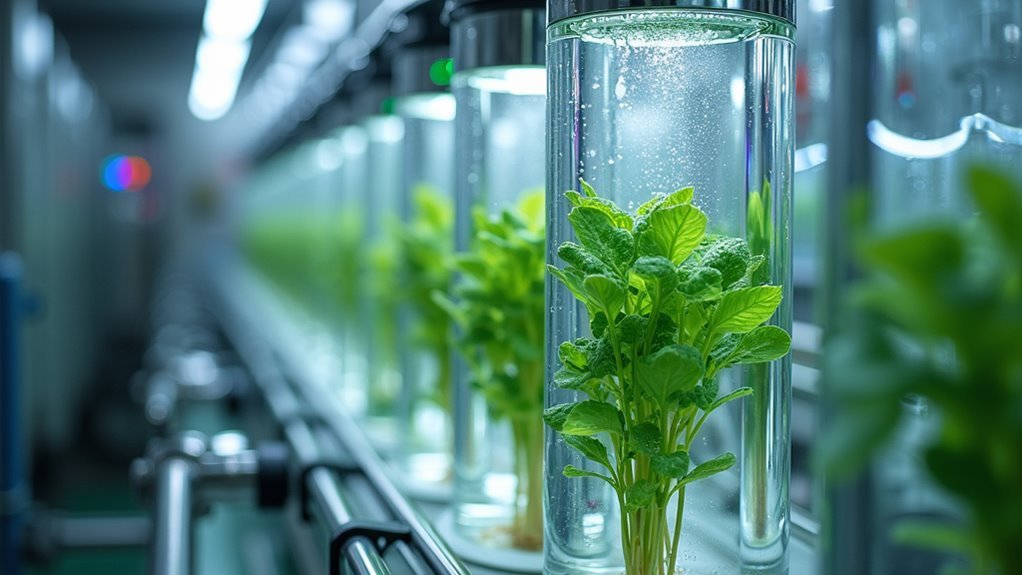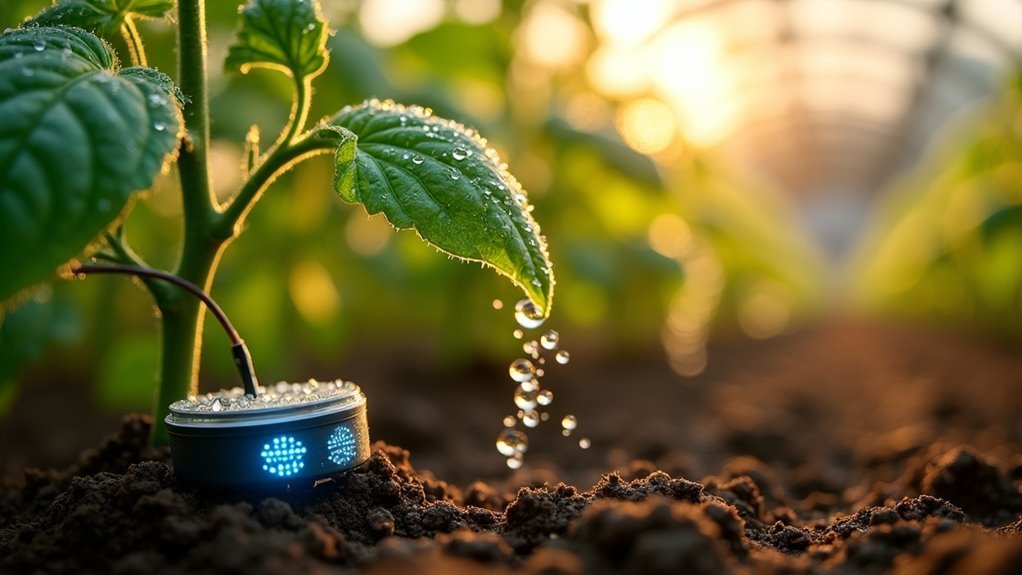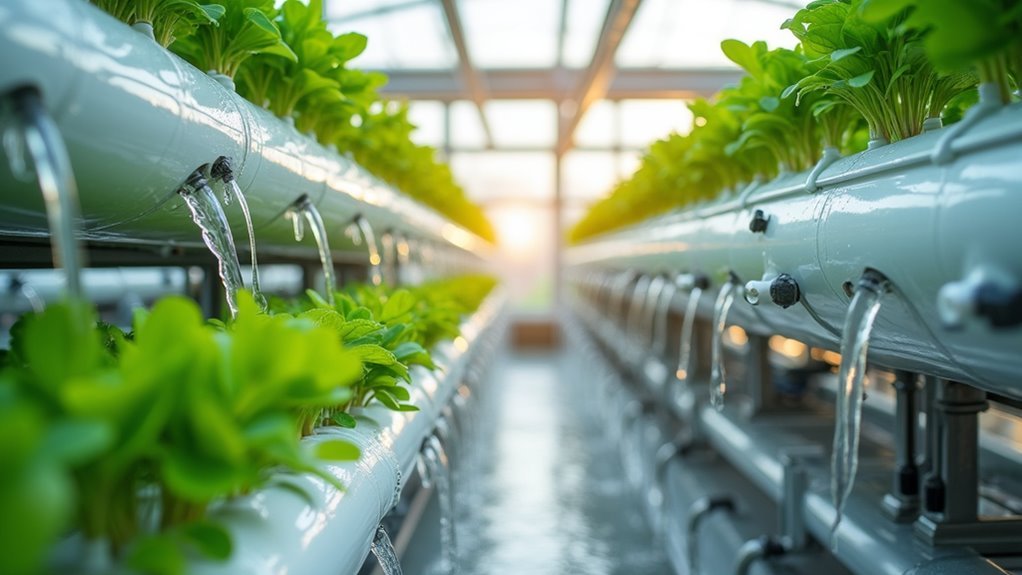You’ve probably watched water drain from your plant saucers countless times, never considering its potential. Smart plant water recycling transforms this everyday waste into a valuable resource through automated systems that collect, filter, and redistribute water back to your plants. These intelligent networks use sensors and AI to monitor water quality while reducing your household’s freshwater consumption by up to 40%. But there’s more happening beneath the surface than you’d expect.
Understanding Smart Plant Water Recycling Systems

As water scarcity becomes an increasingly pressing global concern, smart plant water recycling systems offer a revolutionary approach to wastewater management that transforms contaminated water into a valuable resource.
These smart water systems collect wastewater from sinks and industrial processes, then employ AI-powered filtration technologies for safe reuse. You’ll find IoT monitoring tracks water quality in real-time, ensuring recycled water meets safety standards for non-potable applications like irrigation and toilet flushing.
Advanced purification processes, including nanotechnology, effectively remove contaminants to improve recycled water quality. By implementing water recycling through automated systems, you’re supporting sustainability initiatives while reducing freshwater reliance and enhancing water management efficiency throughout your facility.
How Smart Plant Water Recycling Works
When you implement a smart plant water recycling system, it begins by collecting wastewater from multiple sources throughout your facility, including sinks, showers, laundry facilities, and various industrial processes.
Advanced purification technologies then treat this collected water using AI-powered filtration systems that remove contaminants and guarantee safety for non-potable applications.
Smart technology integrates IoT monitoring to track water quality continuously, optimizing filtration efficiency and preventing contamination.
Real-time analytics guide automated distribution systems that deliver treated water precisely where it’s needed, whether for irrigation, toilet flushing, or cooling systems.
This intelligent approach maximizes recovery rates while minimizing waste, helping you achieve significant cost savings and contribute to environmental sustainability by reducing freshwater demand and wastewater discharge.
Core Technologies Powering Plant Water Recycling

You’ll find that smart plant water recycling relies on two fundamental technologies that transform how facilities manage their water resources.
AI-powered filtration systems adapt automatically to changing water conditions, optimizing purification processes without constant human intervention.
IoT monitoring solutions provide you with real-time data on water quality and usage patterns, enabling precise control over your recycling operations.
AI-Powered Filtration Systems
While traditional filtration systems rely on static parameters and manual adjustments, AI-powered filtration systems revolutionize water recycling by employing machine learning algorithms that continuously optimize purification processes in real-time.
These intelligent systems analyze sensor data to adjust filtration parameters automatically, ensuring superior water quality while reducing water consumption and energy usage.
You’ll benefit from predictive capabilities that anticipate maintenance needs and system performance, minimizing costly downtime.
The machine learning technology enables significant reductions in chemical usage, lowering operational expenses and environmental impact from residues.
Through AI integration, your water recycling facility achieves higher recovery rates and more sustainable management practices.
These systems deliver enhanced efficiency, cost savings, and environmental benefits compared to conventional filtration methods.
IoT Monitoring Solutions
IoT monitoring solutions transform plant water recycling by deploying interconnected sensors throughout your facility that continuously collect and transmit critical data on water quality, flow rates, pressure levels, and equipment performance.
These sensors provide instant notifications when issues like leaks or contamination occur, enabling you to respond promptly and minimize water loss. Real-time data analytics enhance your operational efficiency by tracking system performance and identifying optimization opportunities.
You’ll benefit from predictive maintenance capabilities that detect potential equipment failures before they happen, reducing downtime and maintenance costs.
Smart meters integrated with IoT technology help you understand usage patterns, optimizing water distribution and reducing wastage.
Additionally, these systems support regulatory compliance by ensuring consistent monitoring and reporting of water quality standards.
IoT Sensors and Monitoring in Plant Watering
You can monitor your plants’ water needs precisely with IoT sensors that detect soil moisture levels in real-time.
These smart sensors eliminate guesswork by measuring exactly when your plants need water, preventing both overwatering and drought stress.
Your irrigation system then responds automatically, distributing the right amount of recycled water at the ideal time for maximum plant health and water conservation.
Real-Time Moisture Detection
How can you know exactly when your plants need water without constantly checking the soil? Real-time moisture detection through IoT sensors provides the answer.
These soil moisture sensors continuously monitor moisture levels and transmit data directly to smart irrigation systems, eliminating guesswork from plant care.
You’ll receive instant alerts when soil moisture drops below your preset thresholds, ensuring water is applied only when needed. This precision delivers impressive results – you can achieve average irrigation savings of 72% and water savings of 34% during drought conditions.
The key to success lies in proper sensor placement. Install them in representative landscape areas, avoiding interference from nearby objects or varying soil types.
You’ll access real-time analytics that optimize both timing and water amounts for healthier plants.
Automated Water Distribution
While real-time detection tells you when plants need water, automated water distribution systems take the next logical step by actually delivering that water without your intervention.
These smart irrigation systems use IoT sensors to continuously monitor soil moisture levels and automatically trigger watering when needed.
Your automated water distribution system offers three key advantages:
- Weather-responsive scheduling – adjusts watering based on local meteorological data to prevent over-irrigation during rainfall
- Remote control capabilities – manage your irrigation systems from smartphones or computers anywhere
- Significant water savings – reduces water usage by up to 34% during drought conditions
However, you’ll need regular maintenance and calibration of your IoT sensors to guarantee accurate readings and peak performance throughout the growing season.
AI-Driven Water Management for Home Gardens

As technology advances, AI-driven water management systems are revolutionizing how you can maintain your home garden while drastically cutting water waste. These smart irrigation technology solutions analyze soil moisture content and weather patterns to deliver precise watering schedules. You’ll reduce water consumption by up to 50% while saving approximately 16% on utility bills.
AI algorithms process real-time data and predict future conditions, preventing over-watering or drought stress. These water management systems integrate seamlessly with your smartphone, allowing remote monitoring and control.
| Feature | Benefit | Savings |
|---|---|---|
| Real-time monitoring | Ideal plant health | Up to 50% water reduction |
| Weather prediction | Proactive adjustments | 16% utility cost savings |
| Remote control | Convenient management | Time and effort saved |
| Automated scheduling | Consistent watering | Reduced plant stress |
| Integration capability | Unified home automation | Enhanced property value |
Water conservation becomes effortless with intelligent automation working continuously for your garden’s success.
Types of Smart Plant Water Recycling Controllers
Innovation in smart irrigation brings you two primary controller categories that transform traditional watering into precision water management.
Weather-based controllers use ET measurements to calculate ideal watering schedules by analyzing temperature, humidity, and solar radiation data. These systems can reduce your outdoor water use by 20% to 43% through intelligent scheduling.
Soil moisture controllers take a different approach by directly measuring volumetric water content and triggering irrigation only when levels drop below your preset threshold. During drought conditions, these systems achieve remarkable 72% average irrigation savings.
Smart irrigation controllers offer three enhancement options:
- Rain sensors – Prevent watering during precipitation
- Wind sensors – Stop irrigation during high winds
- Freeze sensors – Protect plants from frost damage
Investment costs range from $250-$2,500 for weather-based systems and $280-$1,800 for soil moisture controllers.
Automated Filtration and Purification Methods
Beyond smart controllers, your water recycling system requires sophisticated filtration and purification methods that automatically clean and treat water for reuse. These automated filtration systems utilize AI-powered technologies to enhance wastewater treatment efficiency for non-potable applications like irrigation and toilet flushing.
| Technology | Function | Benefit |
|---|---|---|
| Reverse Osmosis | Removes contaminants | Meets safety standards |
| Nanotechnology | Eliminates microscopic particles | Minimizes energy usage |
| IoT-based monitoring | Real-time data analytics | Immediate system adjustments |
Your purification methods incorporate advanced techniques including ultrafiltration and reverse osmosis to guarantee recycled water meets agricultural and industrial safety standards. IoT-based monitoring provides real-time performance data, enabling immediate maintenance and enhancement. This sustainable water management approach considerably reduces freshwater consumption while maintaining peak water quality.
Benefits of Smart Plant Water Recycling Systems
When you implement smart plant water recycling systems, you’ll experience notable reductions in freshwater consumption while cutting operational costs greatly.
These advanced systems reuse treated wastewater for non-potable purposes, delivering substantial water conservation benefits for your operations.
Your smart recycling technologies offer three key advantages:
- Enhanced Water Quality Management – AI-powered filtration and IoT monitoring guarantee recycled water meets safety standards
- Environmental Protection – Reduced contaminant discharge into natural water bodies protects local ecosystems
- Regulatory Compliance – Cost-effective solutions increase property values while meeting industry requirements
You’ll support sustainability efforts through these systems while promoting corporate social responsibility.
The combination of decreased water bills and minimized freshwater sourcing needs makes smart water recycling an economically viable choice that benefits both your bottom line and environmental conservation goals.
Water Conservation Through Intelligent Plant Watering
Smart irrigation controllers revolutionize traditional watering methods by leveraging real-time weather data and soil moisture readings to enhance your irrigation schedules.
You’ll achieve extraordinary water conservation results, with potential reductions of 20% to 50% in outdoor water usage. During drought conditions, soil moisture sensor-based systems can save up to 72% by activating irrigation only when moisture levels drop below predetermined thresholds.
Since outdoor watering represents 30% to 50% of your total household consumption, smart irrigation greatly impacts overall usage. These systems eliminate water waste by preventing over- and under-irrigation, improving your landscape’s health while reducing disease risks.
You’ll need regular maintenance and system adjustments to maximize efficiency and guarantee peak performance in your water conservation efforts.
Cost Savings and Efficiency Gains
Although the initial investment in smart plant water recycling systems may seem substantial, you’ll experience remarkable financial returns that justify the upfront costs.
Smart water recycling systems deliver remarkable financial returns that far exceed the initial investment costs.
These efficiency gains transform your facility into a sustainable operation while delivering significant cost savings.
Smart water recycling delivers impressive operational cost reductions through:
- Water bill savings – You’ll reduce expenses by up to 30% through efficient recycled water utilization.
- Real-time monitoring – IoT-based analytics prevent costly disruptions and optimize resource distribution.
- Property value enhancement – You’ll meet regulatory compliance while increasing long-term asset worth.
Your facility will benefit from automated systems that efficiently distribute recycled water for irrigation and non-potable uses.
This optimization reduces freshwater consumption by up to 50%, creating a more cost-effective and environmentally responsible operation.
DIY Implementation of Smart Plant Water Systems
You’ll need to carefully select the right components for your smart plant water system, including soil moisture sensors, smart controllers, and greywater collection units that match your specific garden needs.
The installation process requires connecting these components to create an automated network that monitors soil conditions and adjusts watering schedules accordingly.
Once operational, you’ll establish regular monitoring routines and maintenance schedules to keep your system running efficiently and maximize your water savings.
System Components Selection
When building your DIY smart plant water recycling system, selecting the right components forms the foundation of an efficient and reliable setup.
You’ll need AI-powered water filtration to purify collected wastewater safely for irrigation. IoT-based water monitoring devices provide real-time analytics on water quality, enabling optimal water management decisions.
Consider these essential components for your system:
- Advanced filtration technologies like reverse osmosis and nanotechnology filters for superior contaminant removal
- Automated water reuse systems that efficiently distribute treated water for irrigation and non-potable applications
- Compliance-certified equipment meeting local and international water reuse guidelines for safe operation
These components work together to create a thorough recycling system that maximizes water efficiency while ensuring safety standards for your plants.
Installation Setup Process
Before diving into the physical installation, conduct a thorough site assessment to determine your water needs and identify the ideal location for your smart recycling system.
Position your setup near existing water sources and target irrigation areas to minimize plumbing complexity.
Start your installation setup by connecting collection systems to wastewater sources like sinks and showers, ensuring proper drainage flow to your treatment unit.
Install your smart technology components, including AI-powered filtration systems and IoT monitoring devices, following manufacturer specifications for maximum performance.
Configure automated distribution networks to deliver recycled water efficiently to your plants.
Connect sensors and monitoring devices to track water quality in real-time.
Test all connections thoroughly before activating your water management system, ensuring seamless integration between collection, treatment, and distribution components.
Monitoring and Maintenance
Since water quality and system performance directly impact your plants’ health, establishing a robust monitoring routine forms the foundation of successful smart water recycling.
Your smart systems require consistent attention to maintain peak performance and achieve substantial water savings.
Essential monitoring and maintenance practices include:
- Real-time monitoring – Install IoT-based sensors that provide immediate analytics, allowing you to make instant adjustments for maximum water reuse efficiency.
- Periodic inspections – Check automated systems regularly, ensuring filtration and AI-powered purification technologies function effectively.
- DIY sensor integration – Add soil moisture sensors that trigger irrigation only when moisture drops below your defined threshold.
Proper maintenance prevents decreased efficiency and water quality issues.
Studies show smart irrigation controllers can achieve 30% to 50% water savings compared to traditional systems when properly maintained.
Integration With Home Automation Networks
As home automation networks become more sophisticated, smart plant water recycling systems can seamlessly integrate with your existing connected devices to create an all-encompassing water management ecosystem.
You’ll gain remote control over watering schedules through smart controllers that automatically adjust based on real-time weather data and soil moisture readings. This water efficient approach optimizes irrigation timing while minimizing waste.
IOT technology enables your system to send instant alerts when water levels drop or maintenance is needed, ensuring you never miss critical interventions.
Connected sensors and controllers communicate with your home network to provide automated data analytics, revealing usage patterns and conservation opportunities.
Smart home networks deliver real-time water usage analytics, uncovering hidden conservation opportunities through intelligent sensor communication and automated monitoring systems.
You’ll receive actionable insights that help reduce water consumption while maintaining healthy plants through intelligent, responsive irrigation management.
Maintenance and Optimization of Recycling Systems
While your smart plant water recycling system offers impressive automation capabilities, you’ll need to maintain its components regularly to preserve peak efficiency and extend its operational lifespan. IoT sensors deliver real-time data about system performance, enabling you to make timely adjustments before issues escalate.
Your maintenance strategy should include:
- Routine filter and pump inspections – Check these components monthly to prevent clogs and mechanical failures.
- Sensor calibration verification – Verify accuracy of monitoring equipment for reliable data collection.
- Automated alert configuration – Program notifications for component replacement schedules and system anomalies.
Performance assessments using Life Cycle Assessment methodologies help you quantify environmental benefits and identify optimization opportunities.
Staff training on proper operation techniques greatly improves system efficiency while reducing long-term operational costs through informed maintenance decisions.
Future Trends in Smart Plant Water Management
Looking ahead, you’ll witness revolutionary advances in smart plant water management that’ll transform how industrial facilities approach water conservation and recycling.
AI and IoT technology integration will enable real-time monitoring and predictive analytics, optimizing water usage through intelligent resource allocation. You’ll see decentralized recycling systems gaining momentum, reducing dependence on centralized treatment facilities while improving local water management efficiency.
Blockchain technology will revolutionize transparency in water usage tracking, creating accountability and seamless data sharing among stakeholders.
Advanced filtration technologies, particularly nanotechnology applications, will dramatically enhance water quality and treatment process efficiency. These innovations guarantee safer, more sustainable reuse solutions.
Public-private partnerships will accelerate smart water management implementation on larger scales, driving unprecedented innovation and investment throughout the sector.
Frequently Asked Questions
How Does a Smart Watering System Work?
You’ll use sensors that monitor soil moisture levels and weather data to automatically adjust irrigation schedules. The system activates watering only when needed, preventing waste and ensuring your plants receive ideal water amounts.
What Is a Water Recycling Plant?
You’ll find a water recycling plant processes your used wastewater from homes, industries, and farms. It removes contaminants through biological treatment, filtration, and disinfection, creating safe water for irrigation and industrial cooling.
What Are the Disadvantages of a Smart Irrigation System?
You’ll face high upfront costs ranging from $250 to $2,500, require regular maintenance, deal with weather-related reliability issues, risk user setup errors, and encounter potential compatibility problems with existing systems.
What Is Smart Water Treatment?
You’ll find smart water treatment uses IoT sensors, AI, and advanced filtration like reverse osmosis to automatically monitor water quality, predict maintenance needs, and optimize treatment processes for safer, more efficient water management.





Leave a Reply